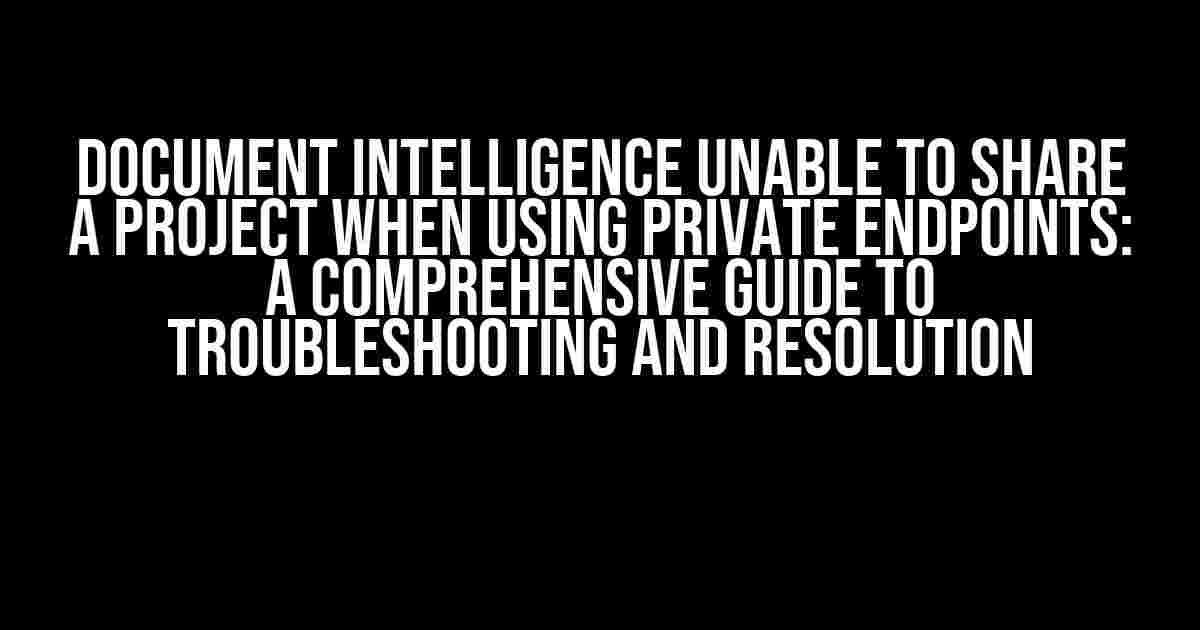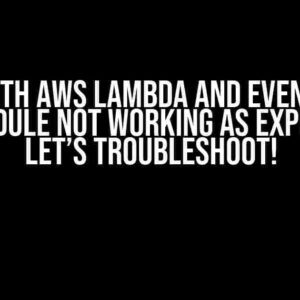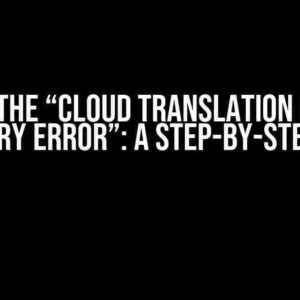Welcome to this in-depth guide, where we’ll delve into the intricacies of Document Intelligence and private endpoints, and provide you with a step-by-step solution to overcome the hurdle of sharing projects when using private endpoints. So, buckle up and let’s dive in!
The Problem: Document Intelligence and Private Endpoints
Document Intelligence is an incredibly powerful tool for extracting insights and value from unstructured data. However, when using private endpoints, sharing projects can become a daunting task. You might have encountered an error message stating, “Document Intelligence unable to share a project when using private endpoints.” But don’t worry, we’re here to help you troubleshoot and resolve this issue once and for all!
What are Private Endpoints?
Private endpoints are a feature in Document Intelligence that allows you to host your data and models within a secure, isolated environment. This provides an additional layer of security and control over your sensitive data. However, this isolation can sometimes lead to connectivity issues, making it challenging to share projects with others.
Troubleshooting Steps
Before we dive into the resolution, let’s go through some troubleshooting steps to ensure we’ve covered all the bases:
-
Verify that your private endpoint is correctly configured and running.
// Check the status of your private endpoint
az document-intelligence private-endpoint show --name -
Ensure that the necessary permissions are in place for the user attempting to share the project.
// Grant the necessary permissions to the user
az role assignment create --assignee--role "Document Intelligence Project Contributor" --scope / subscriptions/ /resourceGroups/ /providers/Microsoft.DocumentIntelligence/privateEndpoints/ -
Check the project settings to ensure that sharing is enabled.
// Get the project settings
az document-intelligence project show --name--resource-group
Resolution: Configure the Private Endpoint for Project Sharing
Now that we’ve troubleshooted the issue, let’s dive into the resolution. To share a project when using private endpoints, you’ll need to configure the private endpoint to allow incoming requests from the Document Intelligence service.
Step 1: Get the Private Endpoint ID
First, you’ll need to get the ID of your private endpoint:
az document-intelligence private-endpoint show --name--resource-group --query "id"
Step 2: Create a New Network Rule
Create a new network rule to allow incoming requests from the Document Intelligence service:
az network rule create --name AllowDocumentIntelligence --resource-group--private-endpoint --direction Inbound --protocol Tcp --source-port-range * --destination-port-range 443
Step 3: Update the Private Endpoint
Update the private endpoint with the new network rule:
az document-intelligence private-endpoint update --name--resource-group --add network-rules AllowDocumentIntelligence
Step 4: Verify the Configuration
Verify that the private endpoint is configured correctly:
az document-intelligence private-endpoint show --name--resource-group --query "networkRules"
Sharing the Project
Now that the private endpoint is configured, you can share the project with others:
-
Go to the Document Intelligence portal and navigate to the project you want to share.
-
Click on the “Share” button and select “Private Endpoint” as the sharing method.
-
Enter the email address or username of the user you want to share the project with.
-
Choose the desired permissions for the shared user.
-
Click “Share” to share the project.
Conclusion
You’ve made it! By following this comprehensive guide, you should now be able to share your Document Intelligence project with others even when using private endpoints. Remember to troubleshoot any issues that may arise, and don’t hesitate to reach out if you need further assistance.
| Troubleshooting Step | Resolution Step |
|---|---|
| Verify private endpoint configuration | Get private endpoint ID and create a new network rule |
| Check user permissions | Grant necessary permissions to the user |
| Verify project settings | Update private endpoint with new network rule |
With this guide, you’ll be well on your way to unlocking the full potential of Document Intelligence and private endpoints. Happy sharing!
Note: This article is for informational purposes only and is not officially affiliated with Microsoft or Document Intelligence.
Frequently Asked Question
Get the inside scoop on Document Intelligence’s private endpoint conundrum!
Why can’t I share a project when using private endpoints in Document Intelligence?
When you’re using private endpoints, your project is essentially hidden from the outside world. To share a project, you need to either switch to public endpoints or whitelist the IP addresses of the users you want to share with. That way, they can access your project without any hiccups!
Are private endpoints the only reason I can’t share my project?
Nope! There could be other reasons why you can’t share your project. Double-check that you have the necessary permissions, and that your project isn’t already shared with someone else. Additionally, make sure you’re not hitting any sharing limits or violating any security policies. If you’re still stuck, feel free to reach out to our support team for a helping hand!
Can I use both public and private endpoints for different projects?
You bet! Document Intelligence allows you to use public endpoints for projects you want to share freely, and private endpoints for projects that require an extra layer of security. Just remember to configure the endpoints correctly for each project, and you’re all set!
Will using private endpoints affect my project’s performance?
Private endpoints might introduce a slight latency, but it’s usually negligible. The benefits of added security and control often outweigh any minor performance differences. If you do notice any performance issues, our support team is here to help you troubleshoot and optimize your setup!
Are private endpoints compatible with all Document Intelligence features?
Almost! While private endpoints work seamlessly with most Document Intelligence features, there might be some limitations or restrictions with certain advanced features or integrations. If you’re unsure about compatibility, our support team can provide guidance and help you find the best solution for your use case.



